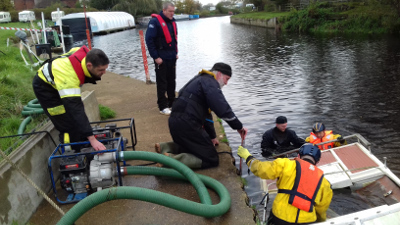Covering all eventualities
MANY scenarios meet the teams from River Canal Rescue when they attend a problem, which means the training to tackle them has to be kept up to date.
So 34 staff from the breakdown and assistance firm were recently put through their paces during a week of rescue training at Red Hill Marina on the Soar.
 How to access risks
How to access risks
Front-line engineering and office-based staff first went through the theory of a rescue, learning how to assess risks, formulate plans for safe rescue attempts and how to use rescue equipment safely and efficiently.
Simulated rescues followed involving the sinking and re-floating of an 18ft cruiser, sunk to varying levels of raising difficulty (six times during each day). There were also powerboat rescue scenarios including man-over-board and high-speed manoeuvres and personnel rescue scenarios including a capsized vessel, plus throw bag, tow and personal water safety training, with Operations manager, Jay Forman explaining:
Like to train in a river
“If Health & Safety allows, we like to train in a river as this is where our most risky and difficult rescues are undertaken. The river flow and depth of water enables us to recreate difficult situations we’ve encountered in the past—without taking any risks.”
During the simulated rescues a chief and second in command are always present as trainers. Rescue workers are appointed, as they would be in a real rescue and assigned to tasks. Seniority given to the trainees is determined by the number of rescues they have undertaken in the past, with Jay adding:
Logged sat least 100 rescues
“The chief must have logged at least 100 rescues and the second in command, a minimum of 80 to be given control in a real-world situation. However for training purposes, trainees will be given duties far more advanced than would usually be expected of them. Any trained member of staff can attend as a rescue worker, but they are usually put on light duties until they’ve taken part in at least 10 real-world situations.”
Office staff are included in the training as they regularly support rescue teams that are called to attend incidents and are now active members of the rescue teams. Rescue training is held once or twice a year, dependent upon the number of call-outs.
